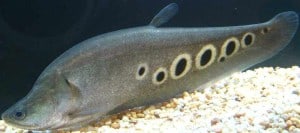
Common name: Clown Knifefish
Scientific name: Chitala Ornata
Average Adult Fish Size: 40 inches / 100 cm in the wild, but smaller in aquariums.
Place of Origin: Asia. Mekong basin in Laos, Thailand, Cambodia and Viet Nam; Chao Phraya and Meklong basins.
Typical Tank setup: Nocturnal. This species requires a very large well planted, or at least well decorated, aquarium. It is best not to keep more then one of these fishes together in an aquarium unless it’s big enough for several territories to be formed. The aquarium should be decorated with a lot of narrow hiding places among roots, rocks and plants. Floating plants should be used to dim the lighting.
Recommended Minimum Aquarium Capacity: 140 gallon / 560 litre, at least initially.
Compatibility: Can be very aggressive with others of its own kind, but it is normally peaceful towards other large fish. Do not keep with fish that are small enough for it to eat.
Temperature: 72 – 82 Deg F / 24 – 28 Deg C
Water chemistry: pH 6.0 – 8.0
Feeding: Smaller specimens will accept most kinds of live and frozen food. Once trained some accept pellets and will try different foods. Some specimens will only eat at night, or when there is subdued lighting. If kept with large tank mates make sure your knife gets its fair share of food.
Sexing: It isn’t possible to sex this species
Breeding: This species is hard to breed. Only fully grown specimens will breed. Use very soft water and lots of floating plants which can be used as substrate for the eggs. Sometimes hard substrates are used. The males guard the eggs until they hatch. Incubation time is about 1 week. Males are usually good guards. Fry can be feed artemia. It is best to move the fry to a separate aquarium once they hatched. Since it isn’t possible to sex this species it’s best to keep a larger number of specimens (6) together in a large aquarium or pond if you want to breed them.
Additional Information: An interesting fish that needs a lot of space to be at its best. Adequate filtration and frequent partial water changes are a must as large specimens produce a lot of waste.


Related Posts
Croaking Gourami – Trichopsis vittatus
Benthochromis Tricoti
Large-eyed Mouthbrooder – Callochromis Macrops